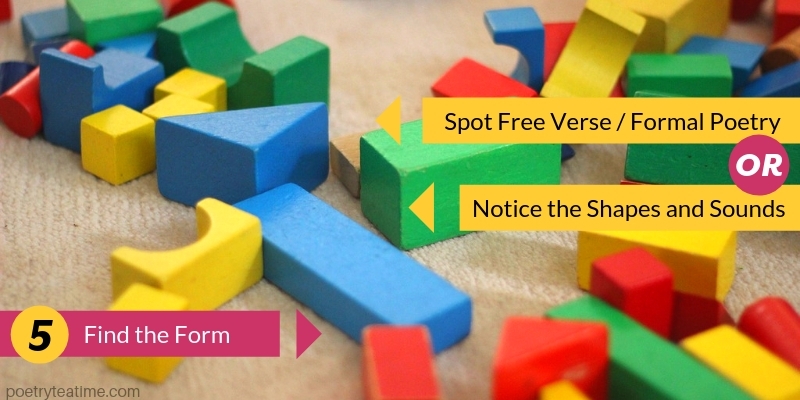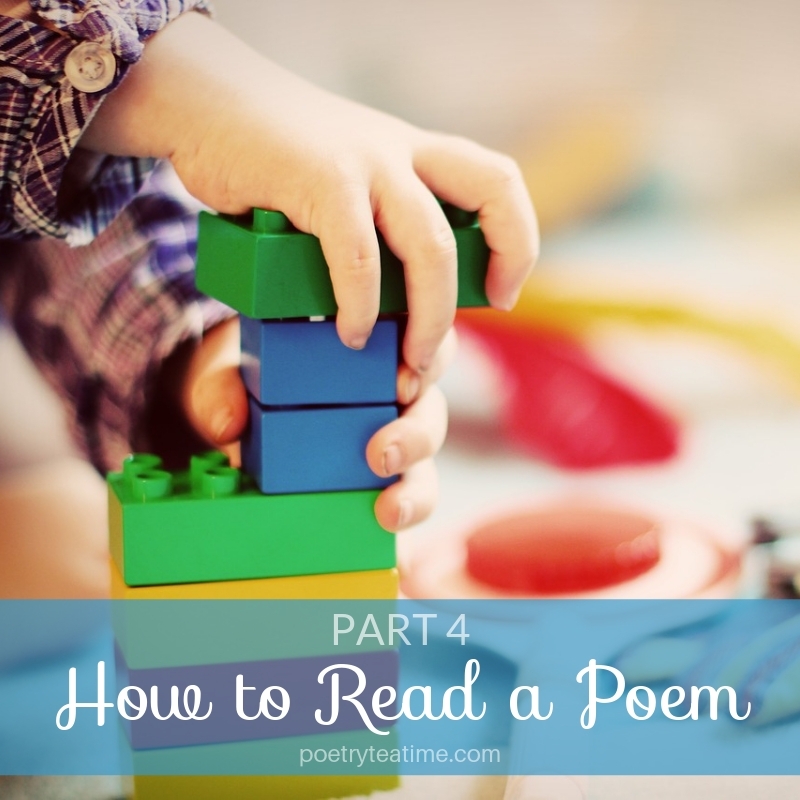Today is our chance to get into the element that makes a poem look so different from other types of writing: its form. We’ll be looking at line breaks, enjambment, and all sorts of delightful poetic play! So buckle up and get your building blocks ready for some fun with form!
[This post contains Amazon affiliate links. When you click on those links to make purchases,
Poetry Teatime receives compensation at no extra cost to you. Thank you!]
Before we begin, make sure you’re caught up with our previous entries on How to Read a Poem: Getting Started, the Big Picture, and Poetic Language.
Starting with Basics: The Line
The most basic building block of poetry is the line. A line in poetry means the writing doesn’t go all the way to the right side of the page. Instead, it
Stops
Somewhere in the middle
With or without punctuation at the end of the line.
The end of the line is called the line break, and if the sentence continues without punctuation past the line break, that’s called enjambment.
Why is poetry written like this?
While not all poems use lines, especially poems in non-Western languages, most poems in English and many other languages do use lines. While the reason that poetic lines first developed depends on the scripts and poetic styles of different areas, there are a few general reasons why poetry uses lines.
Lines….
- Make the poem stand out visually
- Echo the repetition of sounds, especially in rhyming poetry
- Help when memorizing long pieces of text
- May have developed alongside music and lyrics, which are also often written in lines
- Show patterns of sound and visual elements more clearly
Why do you think poetry developed using lines?
Finding the Form of a Poem
When you're finding the form of a poem, you can approach it in two ways: either find the exact category of the poem (free verse or formal poetry), or notice the more general shapes and sounds of the poem.
You don't need to know the exact type of poem you're reading to understand the poem. However, knowing the type of poem might help you gain more appreciation for the choices the poet is making.
Either way, let's dive into form!
Option 1: Spot Free Verse / Formal Poetry
If you want to find the category of poem you're reading, you'll want to know whether it's a formal poem or free verse. Both types are (almost always) made up of lines that are arranged together in stanzas (groups of lines) rather than paragraphs.
How do you spot what kind of poetry you’re reading?
Free Verse
Free verse poems don’t follow any rules about line lengths or number of lines in each stanza, and they also don’t have a set rhythm or rhyme scheme. When you read them out loud, free verse poems often sound similar to the way people speak.
If you see a poem with lots of different short and long lines, or a poem that’s arranged in interesting ways on the page (like a concrete poem), chances are you’re reading a free verse poem!
Remember, free verse poems still use line breaks and poetic language (images, metaphors, repeated sounds or rhythms, and other tools to make the poem more vivid, surprising, and powerful). You can find out more about free verse poetry at this link from Poetry Teatime.
Formal Poetry
On the other hand, formal poetry is based on specific rules, so these poems have similar-looking line lengths, stanza lengths, or a strong pattern of rhythm and rhyme. Some types of formal poetry you might recognize are the sonnet, the ballad, and the haiku.
Once you know you’re dealing with a formal poem, the next step is to figure out what type of poem you’re reading. To do this, there are two steps.
- Count the total number of lines (for example, a sonnet has 14 lines while a haiku has 3) or the number of lines in each stanza (a ballad usually has four lines per stanza).
- Then, check to see if the poem has a repeated pattern of rhymes at the end of each line or if entire lines or sections repeat (both ballads and villanelles include repeated sections).
If you know the number of lines and the type of rhymes, you may be able to recognize it right away, or you can look up that pattern online or in a poetry book. We’d recommend using The Making of a Poem: A Norton Anthology of Poetic Forms, edited by Mark Strand and Eavan Boland, to introduce you to different types of formal poems.
Why should you pay attention to what form a poem has?
The rules a poem follows can help point you to the meaning of a poem. For example, the repeated section of the ballad, called the refrain, is usually the most important part of the poem. It includes the most heartfelt and deepest feelings of the speaker in the poem.

Option 2: Notice Shapes and Sounds
Even though knowing the type of poem you’re reading can help clue you in to what to expect, you don’t need to know the type of poem to read and understand the poem.
You can understand and appreciate poetry without having to assign it a label, classify it, dissect each rhyme, or pick apart the rhythm.
That’s why we put looking at the form toward the end of our series on how to read a poem. If you’ve already taken a glance at the poem, read it out loud, looked at the “what is” or “what happened” big picture of the poem, and appreciated the poetic language, then knowing the form of the poem will only deepen your appreciation.
Even without knowing the overall category of the poem, there are some questions you can ask yourself about any poem you’re reading.
- Where does the poet repeat sounds or words?
- Do the sounds of the poem or of certain lines make the poem sound funny, thoughtful, excited, or something else?
- Do any of the words or lines sound like what they mean?
- Where does the poet use line breaks?
- Are there any line breaks that change the meaning of a sentence or word?
- Is the poem split up into different stanzas?
- Do the stanzas look similar or different? Sound similar or different?
- Are they connected to one idea or do they talk about different things?
- How does the poet use the blank space around the words of the poem?
- Does the way the poem looks remind you of anything?
- Is there a rhythm or a beat to any parts of the poem?
- How does the rhythm affect the way you read the poem out loud?
- What does the rhythm make you think of?
These questions will help you investigate how the poet is using words and space to communicate a different meaning, feeling, or visual element to the poem.
So be sure to enjoy the form of the poetry you’re reading!
Next week, we’ll be wrapping up our series on how to read a poem with Part 5 by asking, “So what?” Now that we’ve read these poems and understood how the poetic language and form of the poem helps to contribute to its meaning, it’s time to bring it all together.
How to Read a Poem
Part 1: Getting Started
Part 2: The Big Picture
Part 3: Poetic Language
Part 4: Find the Form
Part 5: So What?



